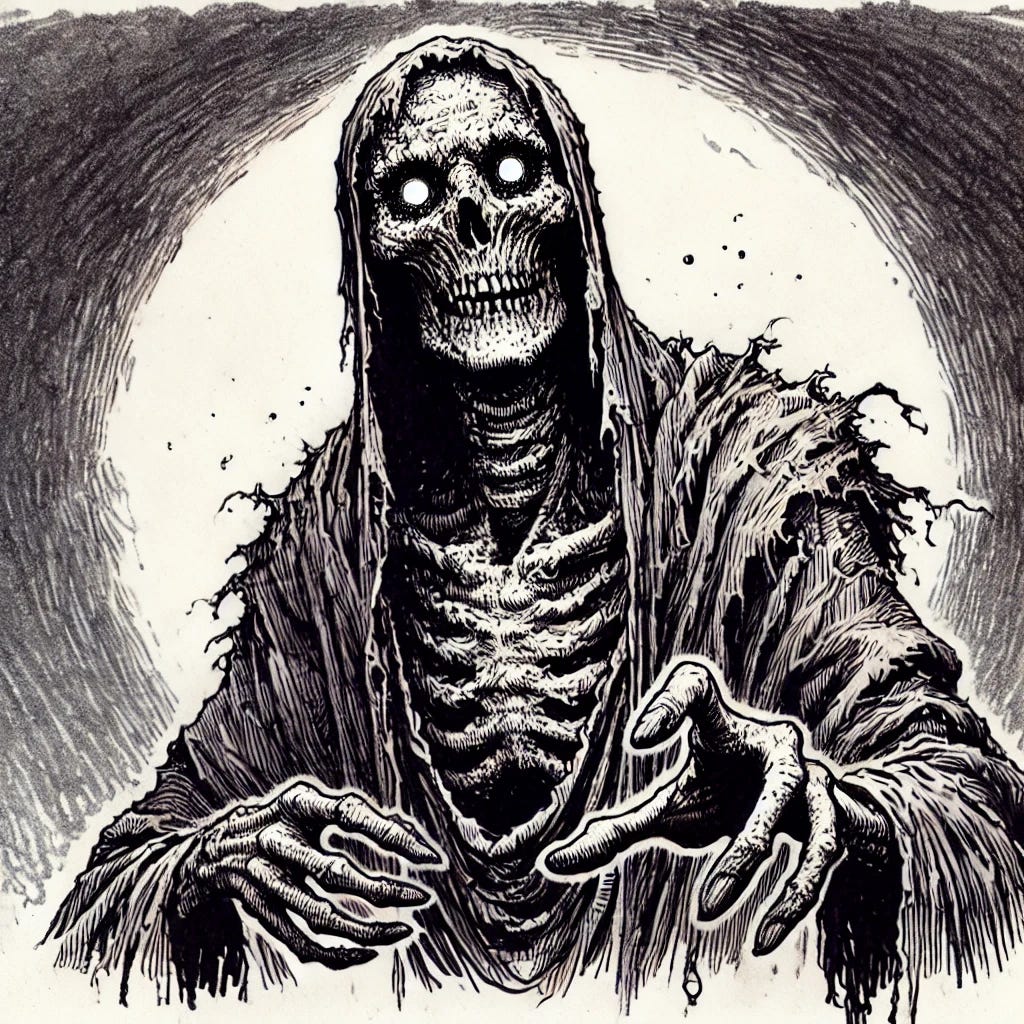The Wight: Undead Menace or Tragic Echo of the Past?
Article of the day...
Wights are the kind of creatures that make you question the very nature of life and death. Lurking in the shadowed corners of dungeons or on forgotten battlefields, these undead horrors are not only the scourge of adventurers but the tragic remnants of once-living beings. They may seem like just another monster to clear off your dungeon crawl list, but there’s a deep well of potential for storytelling and terrifying encounters when it comes to Wights.
What Are Wights?
First off, let’s break down the basics. A Wight, according to Advanced Dungeons & Dragons’ Monster Manual, is an intelligent undead. These creatures were once living beings—usually warriors or nobles—who fell into the clutches of death and were raised by darker forces to continue their existence as evil, soulless parasites.
Physically, Wights are described as having pale, deathly features. Their eyes glow with a faint, unnatural light, and they exude an aura of malevolence that makes the air feel thicker, the shadows darker. They have a chilling ability to drain life from their victims with a single touch, weakening their prey before rising again to join the ranks of the undead.
But it’s not just their physical form that makes them a deadly threat; it’s the mind behind those decaying eyes. Wights retain a semblance of their former intelligence, something that makes them far more dangerous than other mindless undead like Zombies or Skeletons. They have a drive—usually to amass power, terrorize the living, or fulfill the twisted goals they once had in life.
The Horror of the Wight’s Touch
In combat, the Wight is a menace. Their signature ability, energy drain, isn’t just about dealing damage—it’s about taking something irreplaceable from their victims. For every successful attack, a Wight can drain a level of energy from their target, reducing the victim’s strength, skill, or magic. It’s a subtle and insidious attack that doesn’t just wear down the adventurer—it leaves a permanent mark on them, one that can’t be easily healed. Characters who fall victim to a Wight’s touch may find themselves weaker, less capable, and more vulnerable to further assaults.
This unique aspect of their power makes Wights a creature you can’t just throw in front of your players and let them hack away until they die. Wights challenge the very idea of what a fight is supposed to be. Instead of just a war of attrition, it’s a battle of attrition against the essence of life itself. And while a Wight may not have the physical toughness of a zombie or a vampire, their ability to sap the life force of their enemies makes them an insidious threat.
The Wight’s Lair
Wights are often found in lairs that reflect their past lives. An old warrior might make its home in the remains of a battlefield where it once fought, or a noble might haunt a decaying castle, holding on to long-dead ambitions. These lairs are not just places for them to rest—they’re sites of dark power, places where the boundaries between the living and the dead are thinner. They often serve as crypts, secret tombs, or haunted halls filled with forgotten treasures and forgotten regrets.
For a Dungeon Master, this presents a fantastic opportunity. The lair of a Wight can be as important as the Wight itself. Consider the atmosphere—what kind of space would this former ruler or general now haunt? What remnants of their old life still cling to their rotting soul? And most importantly, what is it that keeps them here? Wights often linger long after their original purpose has been fulfilled. Perhaps they’re guarding something—an artifact, a lost treasure, or a key to an even darker secret.
Roleplaying the Wight
A Wight’s motivations, while evil, can be more complex than just “destroy the living.” These were once people, and their thirst for power or vengeance doesn’t just fade after death. A Wight could be a tragic figure—someone who was betrayed in life and now seeks to exact revenge on those who wronged them. Alternatively, they may have been a noble, clinging to their former title and attempting to reign over a domain of the dead with the same ruthless iron fist they once wielded in life.
For roleplaying, this complexity adds depth. A Wight is an undead with more than just mindless hunger. It has goals, it has desires, and it might even have a history that resonates with the adventurers. Perhaps one of the party members can trace their family lineage to a long-dead hero who faced this very Wight—and now the adventurer must face down the consequences of those long-forgotten wrongs. A Wight’s story can be a catalyst for grander narrative arcs, connecting past events to present challenges in ways that few other creatures can match.
A Foe to Fear, A Story to Tell
Wights are more than just an obstacle on the way to loot. They’re a symbol of the consequences of evil that doesn’t die. They are the living, the fallen, and the forgotten, all wrapped into one terrifying creature that transcends simple monster status. Whether you use them as a test of your players’ endurance, a piece of the larger narrative, or as a tragic figure from their past, a Wight is the kind of foe that lingers long after the encounter ends.
As a Dungeon Master, it’s up to you to bring the Wight to life—pun intended. Don’t just focus on the mechanical aspects. Let them haunt your players, challenge their notions of life and death, and serve as a grim reminder of the price of ambition. After all, the best villains are the ones who don’t just threaten your players—they make them think. And when it comes to Wights, that’s the greatest fear of all.




Great write up! Hope you had a good holiday!